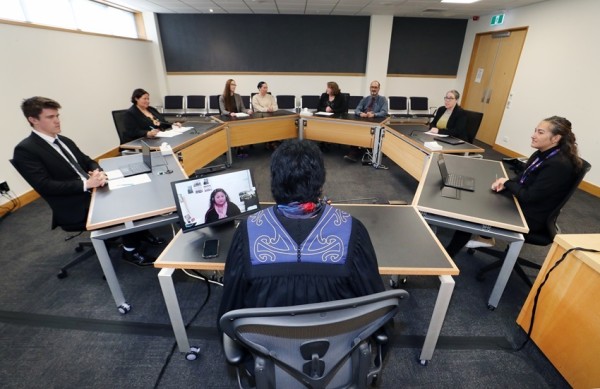Establishing alternative courtroom layouts to make it easier for parties to engage is one of the eight approaches recommended in the Te Ao Mārama Best Practice Framework after their success in specialist courts.
Alternative layouts aren’t possible in every courtroom, for financial, technical and other practical reasons, and aren’t suitable for all hearings, because of the need to ensure everyone's safety, always a priority. But where they are used, they can transform the atmosphere of a hearing.
Options include a boardroom-style table formation (as in the Matariki Court and Alcohol and Other Drug Treatment Court), a ‘horseshoe’-style formation (as in Te Kōti Rangatahi and many Youth Court locations) or simply the judicial officer sitting at the registrar’s rather than judge's bench (as in the New Beginnings Court and many Youth Court locations).
Judge Haamiora Raumati is the Te Ao Mārama lead judge at Gisborne District Court, where courtrooms one and three offer a boardroom, horseshoe or traditional layout. The horseshoe has been used, where appropriate, in the Family Harm Intervention Court since 2020 and the Young Adult List since it was established in 2022. It is also used in the Youth Court.
The horseshoe has been used, where appropriate, in the Family Harm Intervention Court since 2020 and the Young Adult List since it was established in 2022. It is also used in the Youth Court.
The layout allows for an environment that provides for “clear communication, interaction and, more importantly, participation by all in a safe and secure manner”, says Judge Raumati.
Eye contact, open discussion and community involvement have been highlighted in feedback, he says, adding: “It has been my observation that our alternative layout has encouraged connection, respect and positive change.”
Throughout 2024, new forms of alternative layout were tested in the Family Court in Whangārei and Kaikohe.
“In providing a solution best suited to the north, the Te Tai Tokerau Family Court judges opted not for the standard horseshoe or boardroom-style table layouts used in some other parts of the District Court, but instead for five-sided and seven-sided layouts,” says Judge La-Verne King, Te Ao Mārama lead judge in the Family Court at Whangārei District Court.
This layout lets everyone sit alongside each other in a safe way, to encourage participation and the sharing of good quality information. This enables the judge to give a decision or to make directions to meaningfully progress to the next step.
The alternative layouts are set to be the default for Family Court hearings in Northland, apart from those involving family violence or where there are insurmountable security issues around high-tension cases.
In feedback, participants in the alternative layouts said they felt less intimidated with the judge on the same level and having everyone alongside each other. They also felt reassured having wider whānau close to them at a stressful time, which contributed to an increased feeling of calm.
“It felt like a hui rather than a scary court thing,” said one participant. “I like that the judge is sitting with us," said another. "It feels like she is trying to work with us.”
This website explains many of the things you might want to know if you are coming to the Youth Court, or just wondering how the Youth Court works.
 Visit website›
Visit website›
Ministry of Justice website with information on family issues including about going to court, forms and other times when you may need help.
 Visit website›
Visit website›
For information about courts and tribunals, including going to court, finding a court & collection of fines and reparation.
 Visit website›
Visit website›
On this site you will find information about our Supreme Court, Court of Appeal and High Court including recent decisions, daily lists and news.
 Visit website›
Visit website›